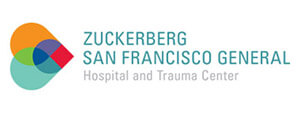Top tips from running our first CAREgiver course

We have been working with Zuckerberg San Francisco General Hospital (ZSFG) since September 2019; researching, designing, and implementing a Train-the-Trainer program. In this first phase of the project, we trained four staff members, providing them with materials such as lesson plans, videos and handouts, to support them in delivering six mindfulness-based sessions to family caregivers in English. We have named this six-session course CAREgivers. In June, after much careful planning and thought, we ran our first CAREgivers course with family caregivers.
The population at ZSFG is more diverse than neighboring hospitals, has higher rates of people who speak English as a second Language, and has a greater number of patients on Medi-Cal and Medi-Care. Part of our project involved understanding the needs of this population and designing our course to be as accessible and attractive as possible to them. In this blog we share five key takeaways for designing for this audience.
1. Not everyone has Zoom!
At Zen Caregiving Project (ZCP) we have been running all of our programs online since the pandemic, asking participants to join via video call to create a sense of online community. At ZSFG, however, some family caregivers can’t use video calls as they don’t have access to a smartphone or laptop, have limited data for video calls, and/or aren’t comfortable using online technology and software like Zoom.
We have designed the CAREgivers course so that participants can call in via cell, landline, or video call, making it possible for anyone to participate in all activities regardless of how they are calling in. Not all family caregivers use email, so we also have simplified registration to a process that doesn’t require an email address. Additionally, as online polls can’t accommodate call-in participants, we don’t rely on zoom polls to collect data.
2. Don’t ask for too many personal details at registration
Some patients and family caregivers at ZSFG may have uncertainty around their immigration status, or may be undocumented, causing anxiety about sharing this type of personal information with institutions. To address and hopefully reduce any such concern, we have limited the amount of identifying information we ask for at registration and in the course and in marketing materials we emphasize that the courses are a safe space.
3. Recruitment takes time, and lots of effort!
Recruitment was particularly challenging this year. Online advertising of our course via email and social media outreach was limited as some of the caregivers we were trying to reach simply didn’t have email or use social media. Physical flyers and posters in clinic waiting rooms were not as effective as usual as COVID-19 meant many patients either didn’t attend sessions in person, or attended on their own without a family caregiver.
In the end, we had the most luck by building networks within the hospital: clinicians were asked to refer anyone they thought may benefit from the course, and we built awareness of the program through social workers and the long-standing Cancer Awareness Resource and Education program (C.A.R.E). But the key to effective referrals was the hard work of a ZSFG team member who reached out to the referred caregivers, introducing the sessions to them, answering any questions they had, and reminding them when the next session was. This personal connection with each individual caregiver was very important in building the trust of attendees.
Initial sign-up numbers were small but we know that building word of mouth takes time and are confident that this number will grow as awareness of, and trust in, the program increases.
4. Keep language simple
Many of the patients and caregivers at ZSFG speak English as a second or third language. While we will be designing courses in both Spanish and Chinese, we wanted the course in English to be as accessible as possible. We also recognized that some caregivers may read at levels lower than those of the general population. In response, we reviewed all of our materials with an aim to adjust the existing language so that it met an 8th Grade reading level. Instead of talking about boundary encroachment, for example, we talked about crossing someone’s boundaries. Instead of using “melancholy” we used sadness, and instead of talking about cultivating self-compassion we talked about growing or building self-compassion.
5. Mindfulness can support everyone, but don’t assume everyone knows what it is.
For some of us, Mindfulness can feel mainstream. It is mentioned in mainstream media, there are hundreds of apps and programs related to Mindfulness and it is being used in everything from professional sports to kindergarten classes.
It is not, however, so mainstream that everyone knows what it is. In our research with family caregivers at ZSFG there were many who had not heard of the concept, although were interested when it was explained to them.
In designing our course we started with the assumption that our audience didn’t know what Mindfulness is. We worked hard to simplify our explanations, adding an additional session to give time to explain and discuss the approach. We also removed any explicitly Buddhist language like “Sangha” or “Dharma”, and grounded our explanations in real world examples to show how Mindfulness could be practically used in daily life.
Next steps
We will be running our second CAREgivers course later this year, and courses will continue throughout 2022. We also hope to transition to in-person sessions, as the city begins to open up after the pandemic lockdown. To read more about the program please see our previous blog on the start of the project, and the experiences of the Mindful Caregiving Trainees on the project.

